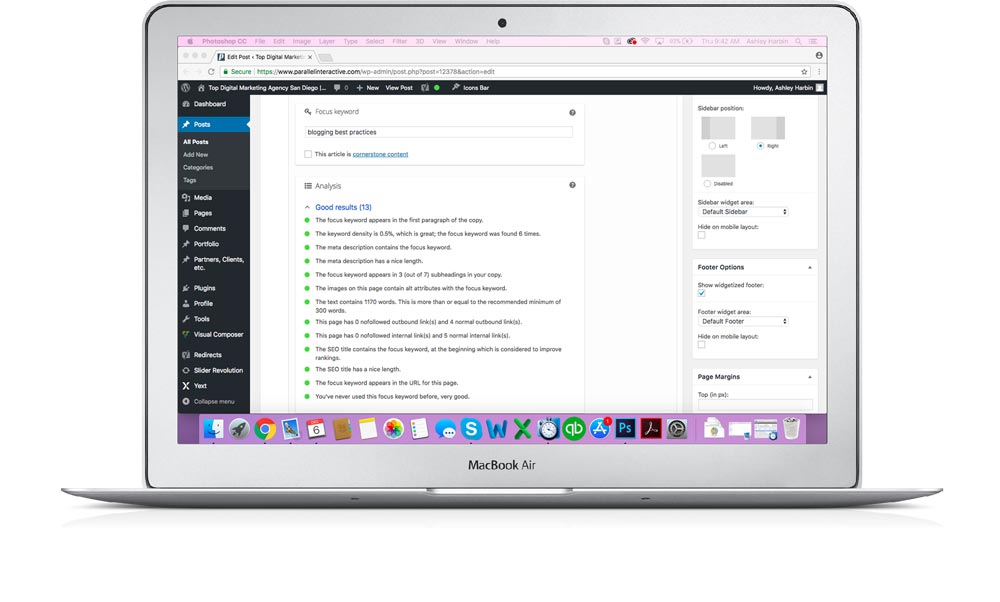Upgrade your content marketing strategy with blogging best practices that increase readability and boost lead generation.
Companies with blogs produce an average of 67 percent more leads monthly. Blogging is such a scalable and affordable approach, making it the one of the three primary content strategies for businesses, and marketers who prioritize blogging see 13 times the ROI compared to those that don’t. When developing an effective content marketing strategy, it is important to keep blogging best practices in mind.
Formatting a Blog Post
As content marketing continues to flourish and more people are turning to blogs for information, it is essential that your high-quality content is useful, relevant, and engaging. According to Patel, 91 percent of the most successful business bloggers publish at least once per week. By regularly developing interesting content, your business can consistently generate leads.
Although quality matters more than quantity, there has been a steady increase in blog post length over the years. Bloggers are seeing more success with longer content pieces. In fact, 55 percent of bloggers say they see results from blog posts with 2,000 words or more. Google ranks posts with more than 1500 words higher, however, readers only read the first 420 words.
Here are some blogging best practices tips for effective writing and formatting to boost your blog content’s readership:
- Take the inverted pyramid approach to writing each blog by telling the story’s most important information in the first 2-3 sentences and filling in the secondary details further in the post.
- Write consistent actions with patterns to make reading easy for your target audience. A simple section structure could include a problem, solution, and tip that repeats throughout the post. Include varying sentence length to create a rhythm to your writing and make it more engaging.
- Readers are known to pay attention to the first three paragraphs, or content blocks, on a page. In fact, 81 percent of readers look at the first paragraph, 71 percent at the second, 63 percent at the third, and only 32 percent at the fourth. Focus on the first three paragraphs and outline your blog format so that your best points get listed in the first sections of your blog post.
- By writing engaging subheads, you’ll be able to draw readers further into the sections of your posts. The 80/20 rule states that 80 percent of the readers just read the post’s headline, so for every 8 people that read a headline, only 2 actually read the post. The same rule applies to subheads, in which 80 percent of your readers will only read the subhead and not the following section.
- Most readers don’t read the full post, but instead switch between reading and scanning modes. Keep skimmers and scanners in mind when structuring your blog post so they are able to use subheads as anchor points to read the sections that interest them.
- Add interactive elements like images, GIFs, videos, and infographics to keep viewers engaged and inspire continued reading.
Blogging Best Practices Using Yoast SEO
Search is the number one traffic source to blogs across all industries. Before you publish your blog posts, optimize your content with Yoast SEO. In order to properly optimize your content for search engines, the plugin measures multiple aspects of your blog copy. First, you will need to enter a focus keyword, then the SEO analysis will check for the presence of that keyword throughout your content. The keyword must be included the title, first paragraph, heading(s), URL, meta description, and image alt text.
According to Yoast, blog content must be a minimum of 300 words in order to rank, keyword density should be between 0.5 and 2.5 percent, and the meta description should be 155 characters or less. Your copy should also include at least one internal and external link. When the criteria are met, Yoast will reward you with a green bullet. Red bullets are items that should be addressed immediately.
 Best Practices for Blog Images
Best Practices for Blog Images
Once your blog is optimized, you can begin adding interactive elements such as images. While only 75 percent of bloggers that place 10 or more photos in an article say it’s effective, only 3 percent actually do this. Blogging best practices include images to engage your readers and boost lead generation.
Images are a great way to break up the text and separate key points to make it easier for readers to understand. You can also incorporate screenshots to help readers visualize the point you are trying to get across. Images should be included frequently in your blog post. The general consensus is one image per 150 words. Also, the number of images you use will vary from post to post depending on the topic. For example, a step-by-step guide should include more images so readers are able to follow the steps exactly, whereas a blog about the benefits of social media marketing will require less. Including poor images is just as bad as not using images at all, so make sure they serve a specific purpose to your already captivating content.
When taking images from the internet, make sure you are legally allowed to use them on your blog. In many cases, you still have to provide attribution to the source if you use a free image. On the other hand, creating your own images can portray consistent branding. Also, try to include pictures of people in order to humanize your content and encourage your readers to take action.
When it comes to image size, it really depends on the subject of the image. You don’t want the image to take up the whole screen and overwhelm the content, but you also don’t want it to be too small for readers to see. Ideally, you want to use landscape images that are not wider than the width of your blog content. You should also compress large images so they don’t take too long to load and slow down your website. Finally, don’t forget to utilize SEO tactics by adding alt text. If for any reason your blog images don’t show up, the browser will load the alt text instead. Using your focus keyword in the alt text allows search engines to crawl your images and rank on Google image search.
Video Blog Best Practices
Copy and images aren’t the only things to consider when it comes to SEO. Videos should also be optimized in order to rank on search engines, increase site traffic, and boost engagement. According to HubSpot, video has even become the most commonly used format in content marketing, overtaking blogs and infographics. Like written content, video SEO best practices include conducting keyword research and applying those keywords in the meta titles and descriptions. Videos should also have transcriptions, schema markups, and site maps to increase the chances that search engines find and crawl your content.
Using Infographics in Your Blog
Like images and videos, infographics are a great way to add visuals to your blog content. By adding infographics to your posts, you can increase engagement, readability, and content retention.
Repurposing Your Blog Content
Over 33 percent of content marketers aren’t updating their content after hitting the publish button, yet those who do update old content are 2 times more likely to report success. Repurposing your blogs can increase ROI by turning them into multiple pieces of content such as infographics, videos, podcasts, case studies, and more. This allows you to reach more potential customers as you publish content on different platforms.
Repurposed content will also boost your SEO boost by building backlinks and driving traffic to your site. Plus, it increases your authority and credibility by positioning your small business as an expert with industry knowledge. We also recommend updating old blog posts with new statistics, content sections, and visuals to keep your content fresh.








